David McFall R.A. (1919 - 1988)
Sculptor
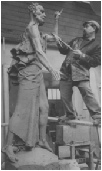
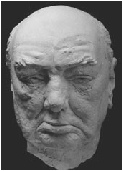
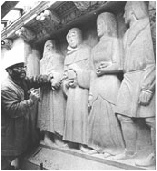
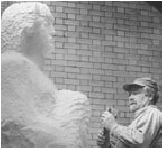

Address by Sidney C. Hutchison for the Memorial Service at St. James’s Church, Piccadilly, London on Tuesday 8th November 1988.
David McFall R.A. (1919 – 1988). In Memoriam.
“I have to confess that I know very little about David McFall’s early life – indeed not much more than he himself revealed for official biographies – but it is clear that he came up the hard way and that his success in life was achieved through sheer grit and perseverance.
It was not an auspicious start to be born amid a working-class background in Glasgow shortly before the Christmas of 1919 when the harsh aftermath of the First World War was beginning to exert its pressures, nor was it much of a prospect to be nearing the end of one’s schooldays in the years of depression of the early 1930’s but, by then, David was determined to become a sculptor and in due course gained admission to Birmingham College of Art where he was given a good grounding and was greatly helped, indeed inspired, by Eric Gill particularly in lettering and direct carving. Subsequently transferring to London, he studied for a while at Lambeth and then at the Royal College of Art. It was quite a long studentship and, by dint of hard work, the young man truly mastered the skills of his chosen profession both in carving and modelling. So much so that, a few years later, he became almost indispensable to Jacob Epstein who was then at the height of his popularity and overwhelmed with commissions. David at first did some lettering for him and, ‘ere long, undertook the casting of many of the master’s pieces although this occasionally meant that his own work had to be put aside temporarily. Epstein’s temper was apparently unpredictable and they appear to have had some exciting times together.
I have known David McFall since 1943 when, aged 23, his first exhibit at the Royal Academy – a carving in Portland stone of a Bull-calf – was purchased for the nation under the terms of the Chantrey Bequest and deposited in the Tate Gallery. Thereafter, for all but one of the next 45 years, he exhibited regularly in the Summer Exhibitions – an astonishing total of 149 sculptures, large and small, mostly in the round but some in bas relief, direct stone carvings and modelling for bronze and other materials. In addition he produced other works not so exhibited but placed immediately on the site prescribed for them.
In style all his sculptures were traditional, in the best and widest sense of the word, but considerably varied in concept. Among them were busts of the famous such as Lord Balfour, Vaughan Williams, Winston Churchill, Clement Attlee, Josiah Wedgwood and the young Prince of Wales, as well as many others from all walks of life. He executed large-scale works, including the pair of gilt-bronze Unicorns which surmount the roof of Bristol Council House, the figures of St. Bride and St. Paul in St. Bride’s Church, Fleet Street, the Churchill statue at Woodford Green and the group of Oedipus and Jocasta at West Norwood Library. And one must not forget that, from 1956 to 1975 a period of 20 years, he was the Master of Sculpture at the City and Guilds Art School in London and that, following Associate-ship of the Royal Academy, he was elected as a Royal Academician in 1963. It was a busy life.
This, however, is not the time and place for a catalogue raisonné of David’s works, industrious as he was, but rather the occasion to attempt a consideration of him as a man – indeed, as a soul. I cannot better the description of him which Bernard Dunstan wrote in an obituary notice – “McFall’s courteous manner, stocky figure and workmanlike bearing hid strong feelings and a deeply sensitive nature, one easily moved and easily wounded. In his work, too, he rarely wore his heart on his sleeve, depending more on rigorous and impeccable craftsmanship and a classic stability. How true! He was of course a real professional and the following comments which he once made on his methods of working provide some insight into his virile character:- ‘Portrait sculpture is a highly nervous performance’, he said, ‘And it really is a performance.’ ‘Anticipating the arrival of a sitter I get very worked up if they’re 10 minutes late. The whole thing is a kind of challenge. And there comes a moment in a sitting when the temperature rises, a certain warmth is struck up. When that happens you’re away, your performance is on …. But the greatest satisfaction comes not in modelling but in carving stone direct. There’s nothing to compare with the act of cutting stone. You see in your mind’s eye what you’re going to cut and, to achieve it and the physical feeling of entering the stone and contact with it, really is the ultimate joy.’
His enthusiasm for his craft was captivating and it was a delight to get him to talk about it. I will always remember his twinkling eyes, his neatly trimmed beard, his quiet smile and, of course, his beret and his bicycle. As a young man he was not averse to a little carousing occasionally, especially during the period of his close association with Epstein, but there was always an underlying seriousness and gentility in his nature and this I believe increased following his marriage, in 1972, to his beloved Alexi. The partnership, strengthened by the birth and growth of their two children, brought a mellowness to his life as reflected in his intimate and smaller-scale figures such as the ‘Girl stepping into a bath’, ‘Alex washing her foot in the hand-basin’, the delightful bust of his daughter at five months and the later ‘Baby Leo’. He had become the father-figure of a family and the tender care for others was now clearly evident in his work.
Unfortunately, due in no small measure to the fickleness of fashion, the kind of sculpture for which David had trained, based on firm tradition and consummate craftsmanship, had become less in demand over the years and there came a time when he found it increasingly hard to make a living from his art. Then, in 1981, the cruel fate of devastating illness struck and any lesser man would no doubt have lost heart completely. Not so David and, in the last period of his life, though subject to great suffering both mental and physical, and lengthy stays in hospital, he embarked on the huge, standing figure of Christ for the precincts of Canterbury Cathedral. Already handicapped by increasing disability, it seemed to be against all odds that he would ever be able to finish it but, characteristically, he embraced the challenge as a gift from God and he completed his part in the miracle (for that’s what it surely was) some month or two before his death. He did not live to see the figure unveiled but I like to think that somehow he was present. David’s declared aim was to show Christ as a fearless man, a prince of the poor and dispossessed, advocating reconciliation, charity and peace – and there is no doubt in my mind that this is what he has achieved. The commanding image, both in its stance and detail, is a true blending of awe and compassion. Besides being his final work, posterity may well deem it to be his finest creation. In accomplishing it he gave himself body and soul to the task and, by so doing, manifested not only his expert craftsmanship but the vigorous strength of his spirit. Let us remember him with admiration and affection.”
Sidney Charles Hutchison (1912 – 2000) was the Historian of the Royal Academy of Art where he worked from 1929 (with a break for war service with the Royal Navy in which he rose to the rank of Lieutenant-Commander). After the war, he returned to the Academy. In 1949 he was appointed the Academy's librarian and in 1955 was named secretary of loan exhibitions. Hutchison soon became the de facto historian of the Academy. In 1956 he published The Homes of the Royal Academy. His History of the Royal Academy, 1768–1968 appeared in 1968. The same year Hutchison was named Secretary to the Academy. During his tenure, the Academy mounted the great Turner exhibition in 1974, another on Pompeii in 1977, and "The Horses of San Marco" of 1981-82. It was Hutchison, who, in 1977 launched the programme of subscription support which brought the Royal Academy back to financial solvency. His scholarly articles included those for the Walpole Society Journal, Apollo, the Encyclopaedia Britannica, and Dictionary of National Biography. He retired as Secretary in 1982.

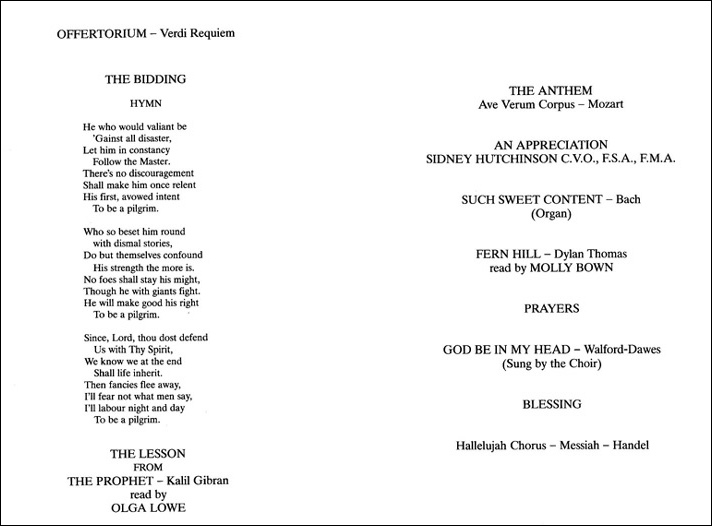
All rights reserved
| Animals |
| Busts and Heads |
| Children |
| Churchill studies |
| Lettering |
| Medals coins plates |
| Reliefs |
| Stone carvings |
| Contemporary British Artists |
| On Epstein |
| Picasso |
| The art of portrait sculpture |
| Letters |
| Palliser |
| Son of Man |
| Press |
| Obituaries |
| Memorial address |